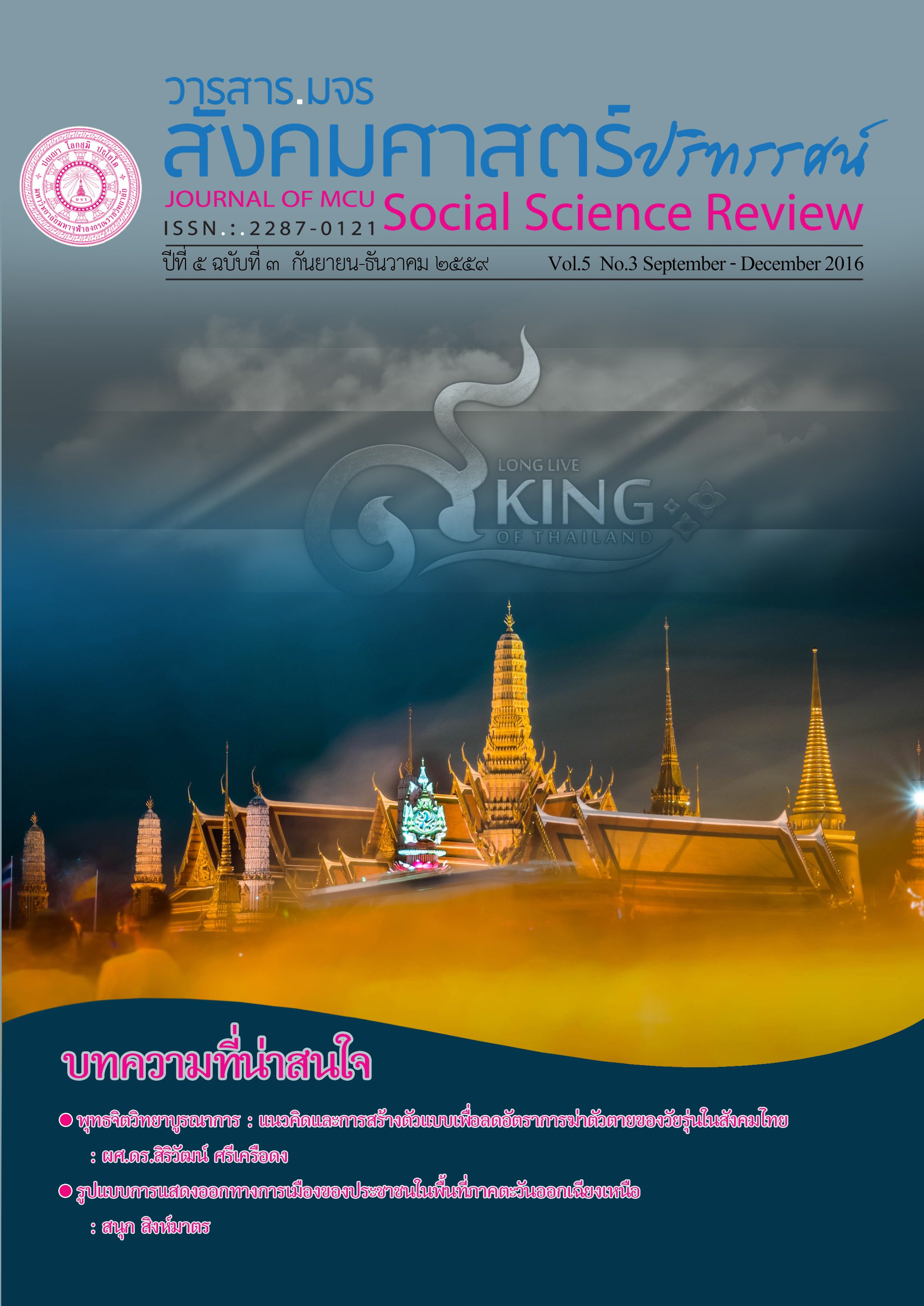การบริหารจัดการเชิงพุทธศาสตร์สิ่งแวดล้อมตามธรรมชาติแนวพุทธของพระสงฆ์ในจังหวัดลำปาง
คำสำคัญ:
สิ่งแวดล้อม, ทรัพยากรธรรมชาติบทคัดย่อ
บทความวิจัยนี้มีวัตถุประสค์ เพื่อ ๑) เพื่อศึกษาแนวดิต ทฤษฎีในการบริหารจัดการเชิงพุทธศาสตร์สิ่แวตล้อมตามธรรมชาติของพระสงฆ์ในจังหวัตลำปาง ๒) เพื่อศึกษากระบวนการบริหารจัการชิงพุทธศาสตร์สิ่งแวตล้อมตามธรรมชาติ ปัญหา อุปสรรค และความสำเร็จของพระสงฆ์ในจังหวัดลำปาง และ ๓) เพื่อสนอแนวทางการบริหารจัตการเชิงพุทธศาสตร์สิ่งแวดล้อมตามรรมชาติแนวพุทธของพระสงฆ์ในจังหวัดลำปาง เป็นการวิจัยผสมเชิงปริมาณและเชิงคุณภาพกลุ่มตัวอย่างที่ใช้ในการวิจัย คือพระสังฆาธิการที่เป็นกลุ่มแกนนำที่ทำงานด้านอนุรักษ์ทรัพยากรธรรมชาติและสิ่งแวดล้อมและประชาชนผู้มีส่วนร่วมในการอนุรักษ์ทรัพยากรและสิ่งแวตล้อมและการสัมภาษณ์ผลการศึกษาวิจัยพบว่า การบริหารจัดการเชิงพุทธศาสตร์สิ่งแวดล้อมตามธรรมชาติแนวพุทธของพระสฆ์ในจังหวัดลำปางได้อาศัยแนวดิตและทฤษฎีในการบริหารจัตการเชิงพุทธศาสตร์สิ่งแวตล้อมตามหลักอริยสั ๔ คือ การพิจารณาถึงเหตุปัจจัย อาศัยศรัทราผสมผสานกับวัฒนธรรมท้องถิ่นในการกระตุ้นให้ชุมชนได้ตระหนักรู้ในการบริหารจัตการทรัพยากรและสิ่งแวตล้อมได้อย่างถูกต้อง อีกทั้งยังมีการสอดแทรกพิธีกรรมหาพระพุทธศาสนา ช่น การศึบชะตาป่า บวชป้า ฯลฯเพื่อให้ชุมชนได้รู้จักความกตัญญตกเวทีต่อรรมชาติและสิ่งแวตล้อม เข้าใจหลักปฏิจจสมุปบาทความสัมพันธ์ระหว่างธรรมชาติกับมนุษย์ ไม่เบียดเบียนธรรมชาติ เพื่อเป็นการดูแล รักษาและป้องกันภัยที่จะเกิดแก่การบริหารจัดการทรัพยากรธรรมชาติและสิ่งแวตล้อม ซึ่งในการบริหารจัตการได้ใช้หล้กอปริหานิยธรรมในการปรึกษาหารือสร้างความสามัคคีในหมู่คณะหรือชุมชนในการจัตกิจกรรมร่วมกันหน่วยงานองค์กรต่างๆ ส่วนพระสงฆ์ได้ใช้หลักพรหมวิหาร ๔ ภาวะผู้นำแก่ชุมชนในการจัดศาสนพิธีกรมที่สอดคล้องกับชุมชน ให้เข้าใจถึงคุณค่าของธรรมชาติหรือคุณค่าทางต้านจิตใจมากกว่าคุณต่าทางต้านวัตถุ
เอกสารอ้างอิง
๒๕.๓๖.
พระเมธีธรมาภรณ์ (ประย รมมจิตโต). ธรรมะกับการอนุรักษ์สิ่งแวดล้อม. กรุงเทพมหานคร: โรง
พิมพ์ บริษัทสหธรรมิก จำกัด, ๒๕๓๘.
มหาวิทยาลัยสุโขทัยธรรมาธิราช. เอกสารประกอบการสอนชุดมนุษย์กับสังคม หน่วยที่ ๑ด - ๑๕.
นนทบุรี: มหาวิทยาลัยสุโขทัยธรรมาธิราช, ๒๕๓๙.
มหาจุฬาลงกรณราชวิทยาลัย. พระไตรปฎกภาษาบาลี ฉบับมหาจุฬาเตปฎก ๒๕๐๐.
กรุงเทพมหานคร: โรงพิมพ์มหาจุฬาลงกรณราชวิทยาลัย, ๒๕๓๕.
กฤษฎา ให้วัฒนานุกูล. "การพัฒนการบริหารตามหลักธรรมาภิบาลขององค์การอิสระด้าน
สิ่งแวตล้อมและสุขภาพ (กอสส.)". วารสาร มจร สังคมศาสตร์ปริทรรศน์. ปีที่ ๔ ฉบับ
ที่ ๓ กันยายน-ธันวาคม ๒๕๕๘.
อนุวัต กระสังข์. "การจัดการสิ่แวตล้อมของวัดตามหลักนิเวศวิทยาเชิงพุทธบูรณาการของคณะ
สงฆ์จังหวัดสระบุรี. วารสาร มจร สังคมศาสตร์ปริทรรศน์. ปีที่ ๔ ฉบับที่ ๒
พฤษภาคม-สิงหาคม ๒๕๕๘.
ชัยยศ อิ่มสุวรณ์. "การพัฒนารูปแบบการศึกษาชุมชนเพื่อการพัฒนาที่ยั่งยืน". วิทยานิพนธ์ดุษฎี
บัณฑิต ครุศาสตร์ (พัฒนศึกษา). บัณฑิตวิทยาลัย: จุฬาลงกรณ์มหาวิทยาลัย, ๒๕๔๐.
ณัฐวรรธน์ สุนทรวริทธิโชติ. "การศึกษาสภาพปัญหาสิ่แวตล้อมในเขตตำบลสามบัณฑิต :
กรณีศึกษา ปัจจัยที่มีผลต่อการพัฒนาทรัพยากรธรรมชาติและสิ่งแวดล้อมของ
ประชาชน". รายงานการวิจัย.กองทุนวิจัย: มหาวิทยาลัยราชภัฏพระนครศรีอยุธยา,
๒๕๕๖.
ประสบสุข พันธุประยูร. "บทบาทของพระสงฆ์ในการอนุรักษ์ทรัพยากรป้าไม้ในจังหวัดภาคเหนือ
ของประเทศไทย". รายงานการวิจัย. สถาบันวิจัยสังคม: มหาวิทยาลัยเชียงใหม่,
๒๕๓๖.
เทศบาลตำบลบ้านสา อำเภอแจ้ห่ม จังหวัดลำปาง[ออนไลน์], แหล่งที่มา:
http://www.bansa.go.th/aboutus.php (ด๔ พฤษภาคม ๒๕๕๘)
สาโรช บัวศรี. การพัฒนาความคิดสร้างสรรค์โดยใช้การจัดการเรียนรู้แบบอริยสัจ ๔. [ออนไลน์j],
แหล่งที่มา: http://www.watphongamschool.ac.th/schoo V/download.,php (๑
ธ.ค. ๒๕๕๗)
สัมภาษณ์พระครูสันติพนารักษ์ อายุ ๕ด ปี, ตo พรรษา, จ้าอาวาสวัดพระบาทสี่ร้อย (ห้วยลูต),
ตำบลบ้านสา อำเภอแจ้ห่ม จังหวัดลำปาง สัมภาษณ์. ๒๖ มิถุนายน ๒๕๕๘.
Richard Tanner Pascale and Anthony G. Althos. The Art of Japanese Management.
New York: Simon & Shuster, 1981.
ดาวน์โหลด
เผยแพร่แล้ว
รูปแบบการอ้างอิง
ฉบับ
ประเภทบทความ
สัญญาอนุญาต
ลิขสิทธิ์ (c) 2016 วารสาร มจร สังคมศาสตร์ปริทรรศน์

อนุญาตภายใต้เงื่อนไข Creative Commons Attribution-NonCommercial-NoDerivatives 4.0 International License.
เพื่อให้เป็นไปตามกฎหมายลิขสิทธิ์ ผู้นิพนธ์ทุกท่านต้องลงลายมือชื่อในแบบฟอร์มใบมอบลิขสิทธิ์บทความให้แก่วารสารฯ พร้อมกับบทความต้นฉบับที่ได้แก้ไขครั้งสุดท้าย นอกจากนี้ ผู้นิพนธ์ทุกท่านต้องยืนยันว่าบทความต้นฉบับที่ส่งมาตีพิมพ์นั้น ได้ส่งมาตีพิมพ์เฉพาะในวารสาร มจร สังคมศาสตร์ปริทรรศน์ เพียงแห่งเดียวเท่านั้น หากมีการใช้ภาพหรือตารางหรือเนื้อหาอื่นๆ ของผู้นิพนธ์อื่นที่ปรากฏในสิ่งตีพิมพ์อื่นมาแล้ว ผู้นิพนธ์ต้องขออนุญาตเจ้าของลิขสิทธิ์ก่อน พร้อมทั้งแสดงหนังสือที่ได้รับการยินยอมต่อบรรณาธิการ ก่อนที่บทความจะได้รับการตีพิมพ์ หากไม่เป็นไปตามข้อกำหนดเบื้องต้น ทางวารสารจะถอดบทความของท่านออกโดยไม่มีข้อยกเว้นใดๆ ทั้งสิ้น





